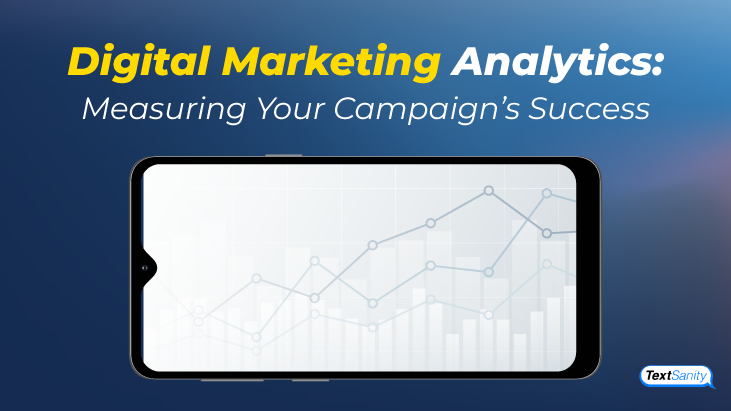Digital Marketing Analytics: Measuring Your Campaign’s Success
If you’ve ever been to a marketing analysis meeting, you’re probably familiar with at least two measures of a campaign’s success. The most well-known metrics are leads and sales. But as we learn that marketing involves our ongoing relationship and communication with our current and potential consumers, we discover other measurable analytics, especially in the world of digital marketing.

There are other goals to consider with digital marketing. Examples of digital marketing goals that can be measured and supported with analytics data:
- Increased organic traffic to a website
-
Increased SMS marketing click-through rate
-
Increased conversions from social media
-
Increased brand awareness from SEO
-
Increased repeat customers from PPC
Building a brand
Whatever your goals for your digital marketing efforts, it’s important to remember that you are not just building a company. In our highly connected environments, it’s vital to realize that you’re building a brand. Branding isn’t boiled down to a company logo. Brands have a look, a personality, and an essence that customers expect and feel when developing a relationship with a company and deciding their loyalty.
It may be hard to imagine how to measure a feeling or an emotional reaction, and it may be even harder to imagine how focusing on this aspect of your marketing will drive sales. But, when you think about your own favorite brands, you may find it difficult to put your finger on what it is that you love about your favorites.
What makes you buy your favorite brand when there are other options to choose from? What makes you like your favorite brand? It’s like trying to explain why your best friend is your favorite friend. They just are, right? It’s hard to explain, but you feel the difference. Developing your brand can make you an unexplainable favorite.
Build a strategic plan
Branding like this needs a strategic plan. You need to communicate who you are, what you’re about, and why the consumer should care. Marketing is the execution of that planned communication and builds brand awareness. Given the digital era, we’re in for the foreseeable future, the most effective means of doing that is through digital marketing.
Digital marketing is a broader field than it used to be, and it offers one of the best features of a successful marketing campaign. Digital marketing, all of it, can be tracked with digital metrics, measured, and analyzed. If your digital marketing can be assessed, then so can your branding efforts. Who doesn’t love being able to see and measure their results?
Your business plan and goals will be the lead deciding factor in prioritizing which digital marketing metrics your brand focuses on. Of course, your marketing efforts also require budget consideration and doability for where you’re at right now. So, once you’ve done all this planning and executing, you want to know how to measure your campaign’s successes. Let’s get into it.
![]()
Measuring success
As in life, before you can determine if something is a success, you need to have a set objective. This is also known as a goal. Your online strategy is going to come directly from your goals.

First, your goals need to be specific rather than vague. You don’t want to put time, money, and effort into your digital marketing and only be left saying, “I think we did pretty good.” You want to know if you achieved what you set out to do. Think specific, and you end up with something more like, “We increased our lunch sales on Tuesday afternoons by 20%.”
Next, you need to commit to a time frame. If you want an increase of, as in our example above, 20% in lunch sales on Tuesday afternoons, you need to know when to stop measuring and what timeframe you want to compare it to. An example of this would be committing to increasing for the month of March and evaluating it in comparison to last year’s March sales or maybe the previous month’s sales.
The difference-maker is that you’re not just indefinitely trying to vaguely do better. You’ll know that your efforts for the month of March had a measurable impact on a comparable timeframe. This timeframe setting helps motivate you by providing an end to shoot for, and you’ll know at the end if the effort is worth repeating or if a new approach is needed.
Final steps
Then, establish the marketing channel you want to employ to implement your goal. As it pertains to our hypothetical goal here, an example would be scheduling text messages to be sent before the lunch rush on Tuesdays to our customers who have opted-in over the last six months to generate that 20% increase.
Finally, after establishing your goals, timeframe, and the specifics of your implementation, you’re ready to go. At the end of your time parameters, you have a defined metric of success, and as it is with the best set goals, your results are quantifiable.
Key performance indicators need to be quantifiable to evaluate their effectiveness. This is another reason it is so important to really drill down into the specifics of your goals. Even if you fall short of your goals, the clear definition will tell you if you need to make adjustments to your plan.
Now that we’ve touched on key performance indicators (KPIs), let’s talk about six of the best KPIs to track through your digital marketing strategy.

Overall website traffic
Overall website traffic is the volume of visits to your websites. This metric doesn’t care about where the traffic comes from, really. This metric focuses on just whether you’re getting people to show up online.

Real-life traffic may give you major anxiety, but that online traffic you see on your website can give you some seriously good vibes. Your website is your brand’s face, so regardless of what other digital marketing techniques you are employing, you’re trying to drive the traffic to this destination. You may have more specific goals under your other marketing channels, but your overarching goal is increasing overall website traffic over time.
You will need to measure your website traffic frequently in order to keep an idea of high traffic times, dips, and sudden jumps in activity. Again, this is quantifiable, and keeping accurate data over time is necessary for measuring other successes.
It might help to think of this as a lot like predicting the weather. Through accurate data records, we know what to expect from the weather for any day based on what other days, just like it did in the past. Accurate overall website traffic data will help you forecast and check results.

Traffic by source
Unlike the overall website traffic, this metric cares about and measures where your site’s traffic is coming. Instead of being eastbound traffic from the major interstate in your area when you think about real-life traffic, you can think of this as conversion traffic from a PPC, promotional response to a mass text, or click-through rates from email.

This metric is one to watch closely. Spikes in traffic after a well-timed text with that new shortened URL can tell you that it was successful. Monitoring your click-through rates from email may tell you that the extra email you added this month crossed that touchy threshold of doing too much.
Knowing if channels are working using this metric will tell you where to focus your efforts. You’re spending valuable time and money creating content for marketing your brand, so you need to know what’s working, what needs tweaking, and what to consider pausing.
Did this traffic come from organic searches? Did I get more direct visitors this week? Did I get a referral boost from another website? Traffic by source can answer all of these questions.

New visitors or returning visitors
This is a dual metric that can help you assess your success in a campaign. Is the content of your campaign proving to be so valuable that people come back again and again? If it is, you need to know.
While it’s awesome to have repeat traffic, if you started a new digital marketing strategy to drive more organic traffic into your website and you do not see an increase in that, you know it’s not having the desired results. Maybe a new strategy for getting new visits is needed.
Conversely, if the mass text you sent to your target audience caused a 15% increase in return traffic on Wednesday night, then you know that attention grabber worked.
![]()
Conversion rate
This metric ties back to that leads and sales that we’re all familiar with. It’s one of our favorite metrics. Did that email blast result in more completed downloads? Did that Saturday morning text increase our customer volume and make actual sales? This metric, while it’s not the only metric, is a clear indication of success.

Summary
Measuring your digital marketing campaign’s success is necessary to determine what works and what doesn’t. Quantifiable results are key, and now you’ll know how to gauge what works and what doesn’t.


